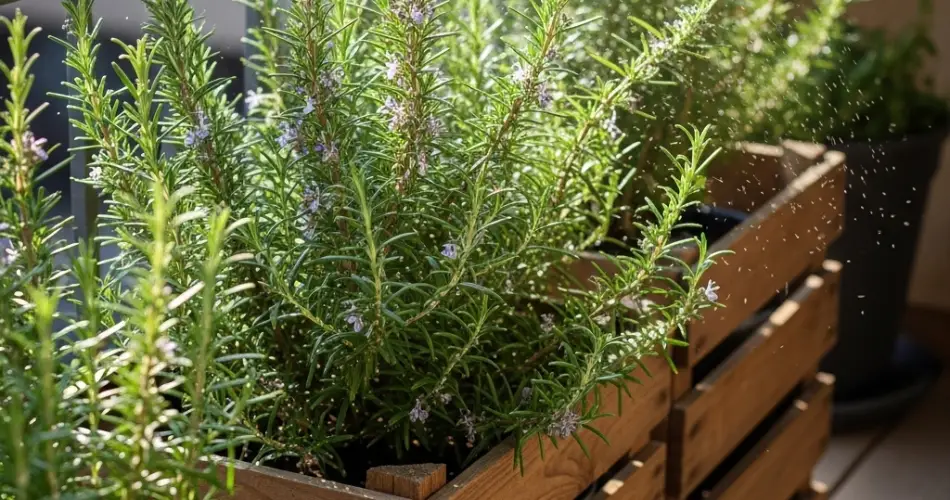Rosemary is one of the most beloved Mediterranean herbs, known for its distinctive pine-like aroma, culinary versatility, and resilience. This woody perennial thrives in warm, sunny environments and can be successfully grown in containers, making it ideal for urban gardeners with limited space. One creative and rustic way to cultivate rosemary is by using wooden crates on a balcony. These crates not only provide a suitable growing environment but also add a charming touch to your garden space.
Here’s a comprehensive guide on how to grow woody rosemary in crate gardens, right on your balcony.
Why Use Wooden Crates for Rosemary?
Wooden crates are a practical and stylish solution for growing herbs like rosemary. Their breathable material helps regulate soil moisture, while their compact size makes them perfect for balcony gardening. A crate at least 30 cm deep and wide offers enough space for rosemary’s long taproot and bushy growth.
Choose sturdy wooden crates—repurposed fruit boxes, old wine crates, or similar containers. Ensure they’re clean and have not been treated with chemicals that could leach into the soil. If you’re using untreated wood, lining the interior with burlap or landscape fabric will help retain the soil while allowing for proper drainage.
Preparing the Crate
Start by drilling several drainage holes in the bottom of the crate. Good drainage is crucial, as rosemary does not tolerate soggy soil. Elevate the crate slightly using bricks or wooden slats to encourage air circulation and prevent water accumulation underneath.
Place a layer of gravel or broken clay pots at the bottom of the crate to improve drainage. Then, fill the crate with a well-draining soil mix. Combine standard potting soil with sand, perlite, or small stones to mimic the rocky Mediterranean soil rosemary prefers. A slightly alkaline pH is ideal, so you can add a small amount of crushed eggshells or dolomite lime if needed.
Planting Rosemary in Crates
You can grow rosemary from seeds, cuttings, or nursery plants. Seeds take longer and may be less reliable, so many gardeners prefer using stem cuttings or transplants.
For cuttings, snip a 10–12 cm long piece from a healthy, woody rosemary plant. Strip the lower leaves and insert the cutting into moist soil. Keep the crate in a shaded area until the cutting establishes roots, which may take 2–3 weeks. Water sparingly to avoid rot.
If using a nursery plant, gently remove it from its container, loosen the root ball, and plant it in the center of the crate. Backfill with soil and pat down gently. Water lightly to help settle the roots.
Ideal Growing Conditions
Rosemary loves sunlight. Place your crate in the sunniest part of your balcony, ideally where the plant receives 6–8 hours of direct sunlight per day. A south-facing or west-facing balcony works best.
Water rosemary moderately. Let the soil dry out completely between waterings. Overwatering is one of the most common causes of rosemary failure, especially in containers. In dry, hot conditions, water once or twice a week. During cooler seasons, reduce watering significantly.
Avoid using heavy mulch or materials that retain moisture around the base of the plant, as this can lead to fungal issues.
Pruning and Maintenance
Pruning is essential to keep your rosemary plant healthy, woody, and compact. Trim the tips regularly to encourage branching and bushier growth. You can start light pruning once the plant is established, but avoid cutting into the older, woody stems, as they may not regenerate.
Remove any dead or yellowing leaves and cut back leggy growth to maintain the plant’s shape. If the crate starts to feel crowded, you can transplant the rosemary into a larger container or trim the roots and refresh the soil.
Every spring, you can give your plant a boost by gently loosening the top layer of soil and adding a bit of compost or slow-release organic fertilizer. However, rosemary doesn’t require much feeding and thrives in relatively lean soil.
Pest and Disease Control
Rosemary is naturally resistant to many pests due to its strong aroma. However, in humid conditions, it may be affected by powdery mildew or root rot. Ensure adequate spacing and air circulation around the crate to minimize these risks.
If pests such as aphids or spider mites appear, spray the plant with a mild soap and water solution or use neem oil. Be careful not to overspray, especially in direct sunlight.
Harvesting and Using Rosemary
You can begin harvesting rosemary once the plant has become established. Use scissors or your fingers to snip off sprigs, cutting just above a leaf node to promote further growth.
Fresh rosemary can be used immediately in cooking or dried for long-term storage. To dry, tie small bunches and hang them upside down in a dry, shaded place. Once completely dry, strip the leaves and store them in airtight containers.
A Rustic Touch to Your Balcony
Growing woody rosemary in wooden crates is a practical and aesthetically pleasing way to cultivate herbs on a balcony. The crates add a rustic, natural charm, and the plant itself provides fragrance, flavor, and a touch of Mediterranean beauty to your home.
With proper care, your rosemary plant will thrive for years, offering fresh herbs and a touch of green tranquility to your urban living space.



